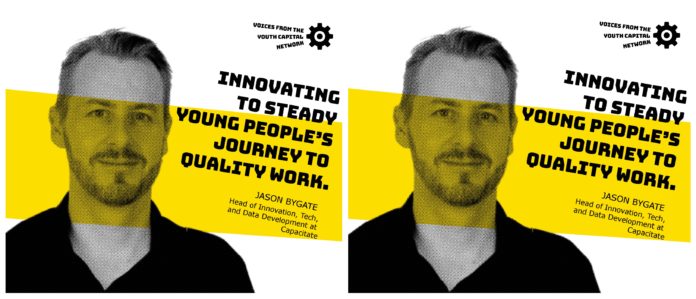Youth Capital releases an annual publication that combines data with young people’s lived stories to shift gears on youth unemployment. The 2021 publication, Unlock Jobs: Clearing Roadblocks to Youth Employment aimed to answer a question. The questions were about how to start clearing the roadblocks on young people’s journey to quality work. To do that, they spoke to several voices from their network. These interviews are published below.
RELATED:
The Daily Vox and Youth Capital partner to inspire young people to #BeTheDrivingForce
Jason Bygate, Head of Innovation, Tech, and Data for Development at Capacitate: Innovating to steady our journey to quality work.
The effects of the pandemic have been catastrophic, touching on all areas of our lives and changing the way that we work, learn, and engage with each other. While we can accept that change is an inevitable feature of our lives, COVID-19 has accelerated this transformation exponentially in some areas.
As we grapple with some of these monumental shifts and manage the uncertainty of which of them will be permanent in a vaccinated post-pandemic state, we find ourselves facing yet another wave of catastrophe.
If we are to avoid or at the very least mitigate some of the consequences of this crisis, we will need a cohesive, integrated approach that leverages the collective capabilities and financial resources of the public and private sector. In addition, we will need to ensure that we can translate holistic policy and programme design into effective and efficient interventions that can be delivered at scale.
Unfortunately, the pandemic has amplified the pressure on an already constrained youth service infrastructure, one that is characterised by:
- Significant resource constraints.
- Fragmentation and isolation across civil society and between the public and private sector with little collaboration.
- Poor integration of services and virtually no sharing of data between ecosystem stakeholders.
- Dated programme approaches with limited innovation.
- Marginal consideration of the youth voice where young people are not treated as active participants driving their own development.
- Archaic technology infrastructure and pervasive manual and paper-based processes.
- Limited technology awareness and skills within organisations.
- Poor visibility of who is doing what, where, and how within the ecosystem.
While there are already some excellent initiatives underway, such as the Basic Package of Support, SAYouth.mobi, Youth Explorer, the Presidential Youth Employment Intervention, Generation Unlimited, AlsoMe!, the Youth Development Collaboration (YDColab), and Yoma; there remains much fragmentation and duplication of effort.
Technology remains a crucial enabler for the formulation of more inclusive, actionable policy and more integrated implementation that can be scaled aggressively within the context of the new world we live in. In addition to providing a basis for driving innovation in the delivery of programmes for youth, technology can help to facilitate a better understanding of the diversity of the youth experience both through assessment and conversation. For example, messaging platforms, social media, chatbots, and even interactive voice response are expanding how we can engage with youth, while incentive platforms like Vollar and Cartedo drive volunteering and active citizenship.
Fintech, micro-eCommerce, and micro-entrepreneurship platforms enable new ways of doing business, expanding how we understand work and creating new opportunities for youth to enter the economy. Moreover, these technologies are changing how we can approach entrepreneurship, providing more diverse opportunities for income generation. Indeed, even the ill-timed focus on building coding and data science skills is beginning to shift as the proliferation of low and no-code platforms provide more accessible, high demand opportunities for youth to embark on the next evolution of digital careers. This is before we even begin considering new prospects that are emerging through AI, the internet of things, and other newer technologies.
Perhaps the most exciting opportunity that technology can enable is in the integration of the youth service ecosystem to allow a more seamless transition between services for youth on their journey into the economy and less of a “cobbled pathway”.
Given the speed of advancement and the excitement that new technologies generate, it is understandable that we might be seduced into believing that there is a silver bullet to avert the impending catastrophe that we face. The technology remains, however, a set of tools that still need to be wielded with skill and great care to avoid causing even more damage and wasting of limited resources.
As a precursor to applying these tools, it is essential to ensure that problems they need to address are well articulated, the context in which they will be used is clear, and the users themselves are well understood. Similarly, the specific requirements of an appropriate solution must be detailed to guide selecting a suitable technology to deliver the solution.
Technology is an essential key enabler for adapting to this changed and changing world that we live in, but it is only one part of the puzzle of youth unemployment that we need to solve. Equally important is collaboration between civil society organisations, government, and the private sector; and the active participation of youth in defining the policies and interventions that they need.
We stand on the precipice of economic and social calamity, the only option is to innovate, integrate, and collaborate in our efforts to transform our demographic risk into a dividend for greater equity and prosperity.
Capacitate was established to drive positive social change by supporting the stakeholders across the social economy. This support is focussed on providing strategic advisory and technical services to global and local agencies, social investors and implementing organisations.
The views expressed in this article are the author’s own and do not necessarily reflect the editorial policies of The Daily Vox.









